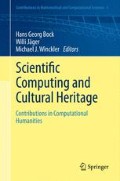Abstract
A sophisticated combination of noise reducing, segmentation and mesh generation methods provides the reconstruction of the surface morphology from three dimensional computed tomography scans of archaeological data as triangular surface meshes. The highly parallelized GPU-enabled implementation of the algorithm processes large data sets in only a few minutes, allowing the systematic reconstruction of various objects. Rendering of the generated triangular meshes and the calculation of the surface area and the volume of the reconstructed items or selected parts of interest, can be done in real time. Those items can also be exchanged by scientists around the world and can be investigated without manipulating the irreplaceable artifacts. The application of computed tomography and the development of archaeological adjusted post processing of the acquired volumetric data enable a non-destructive investigation of the entire object regarding shape, manufacturing techniques or material textures. The reconstructions can also serve as a basis for virtual exhibitions.
Access this chapter
Tax calculation will be finalised at checkout
Purchases are for personal use only
References
All internet references visited in October 2009
Andersonv T, Fell C (1995) Analysis of roman cremation vessels by computerized tomography. J Archaeol Sci 22:609–617
Aumüller M, Lang R, Rainer D, Schulze-Döbold J, Werner A, Wolf P, Wössner U Covise online documentation. http://www.vis.uni-koeln.de/covise/doc/html/tutorial/
Broser PJ, Eberhard S, Heumann H, Heusel A, Jungblut D, Queisser G, Schulte R, Vossen C, Wittum G The neuron reconstruction algorithm. http://www.neura.org
Broser PJ, Schulte R, Roth A, Helmchen F, Waters J, Lang S, Sakmann B, Wittum G (2004) Nonlinear anisotropic diffusion filtering of three-dimensional image data from 2-photon microscopy. J Biomed Opt 9(6):1253–1264
Dimitrov LI, Wenger E, Sramek M, Trinkl E, Lang-Auinger C (2006) VISAGE: an integrated environment for visualization and study of archaeological data generated by industrial computer tomography. In: The e-volution of information communication technology in cultural heritage. The 7th international symposium on virtual reality, archaeology and cultural heritage, Nicosia, pp 50–55, 30.10.–4.11.2006
Fangerau J (2009) Volume Rendering auf Grafikkarten und parallele Implementierung in Cuda. Diplomarbeit, Heidelberg University
Frangi AF, Niessen WJ, Vincken KL, Viergever MA (1998) Multiscale vessel enhancement filtering, vol 1496, Lecture notes in computer sciences. Springer, Berlin, pp 130–137
Greene A, Hartley C (2008) From analog to digital: protocols and program for a systematic digital radiography of archaeological pottery. University of Chicago
Hoppe H, DeRose T, Duchamp T, McDonald J, Stuetzle W (1993) Mesh optimization. In: ACM SIGGRAPH 1993 conference proceedings, pp 19–26
Hoppe H, DeRose T, Duchamp T, McDonald J, Stuetzle W (1993) Mesh optimization. TR 93-01–01, Department of Computer Science and Engineering, University of Washington
Hounsfield GN (1973) Computerized transverse axial scanning (tomography): Part I. Description of system. Brit J Radiol 46:1016–1022
Jungblut D (2007) Trägheitsbasiertes Filtern mikroskopischer Messdaten unter Verwendung moderner Grafikhardware. Diplomarbeit, Heidelberg University
Jungblut D, Queisser G, Wittum G (2009) Inertia based filtering of high resolution images using a GPU cluster. Comput Vis Sci
Kuypers F (2003) Klassische Mechanik, 6th edn. Wiley-VCH, Weinheim
Lang-Auinger C (2008) Corpus Vasorum Antiquorum – Das Österreichische Projekt. Anz ÖAW, phil-hist Klasse 143:57–66
Lorensen WE, Cline HE (1987) Marching cubes: a high resolution 3D surface construction algorithm. Comput Graph 21(4):163–169
Mat-Isa NA, Mashor MY, Othman NH (2005) Seeded region growing features extraction algorithm; its potential use in improving screening for cervical cancer. Int J Comput Internet Manage 13(1):61–70
NVidia (2008) NVidia Tesla C1060 specifications. NVidia
NVidia (2009) Cuda programming guide. Version 2.2
Orton C, Tyers P, Vince A (2001) Pottery in archaeology. In: Cambridge manuals in archaeology. Cambridge University Press, Cambridge, UK, pp 132–151
Otsu N (1979) A threshold selection method from gray-level histograms. IEEE Trans Syst Man Cybernetics 9(1):62–66
Queisser G (2008) The influence of the morphology of nuclei from hippocampal neurons on signal processing in nuclei. Dissertation, Heidelberg University
Si H TetGen A quality tetrahedral mesh generator and a 3D delaunay triangulator. http://www.tetgen.berlios.de/index.html
Weickert J (1998) Anisotropic diffusion in image processing. Teubner, Stuttgart
Acknowledgements
The research was partially supported by a grant of the Styrian government (Department 3 – science and research) and the Excellency Initiative of Heidelberg University. Thanks are due to Georg Geier, Daniel Habe and Jordis-Brit Rosc of the Austrian Foundry Research Institute at Leoben for their obliging help in course of the project. We also thank Sebastian Reiter for implementing the Hoppe mesh optimization algorithm.
Author information
Authors and Affiliations
Corresponding author
Editor information
Editors and Affiliations
Rights and permissions
Copyright information
© 2013 Springer-Verlag Berlin Heidelberg
About this paper
Cite this paper
Jungblut, D., Karl, S., Mara, H., Krömker, S., Wittum, G. (2013). Automated GPU-Based Surface Morphology Reconstruction of Volume Data for Archaeology. In: Bock, H., Jäger, W., Winckler, M. (eds) Scientific Computing and Cultural Heritage. Contributions in Mathematical and Computational Sciences, vol 3. Springer, Berlin, Heidelberg. https://doi.org/10.1007/978-3-642-28021-4_5
Download citation
DOI: https://doi.org/10.1007/978-3-642-28021-4_5
Published:
Publisher Name: Springer, Berlin, Heidelberg
Print ISBN: 978-3-642-28020-7
Online ISBN: 978-3-642-28021-4
eBook Packages: Mathematics and StatisticsMathematics and Statistics (R0)

